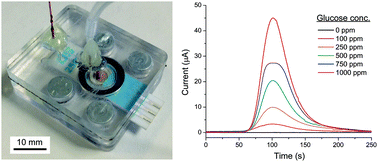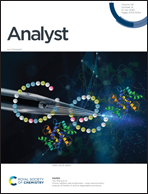On-chip electrochemical detection of glucose towards the miniaturised quality control of carbohydrate-based radiotracers†
Abstract
The miniaturisation of positron emission tomography (PET) radiotracer production is facilitating a move towards a dose-on-demand strategy that would enable a stratified approach to patient diagnostics, but while the on-chip synthesis steps have been demonstrated, the subsequent quality control (QC) testing steps have received much less attention. As part of the development of an integrated QC platform for PET tracers, we have developed two microfluidic electrochemical detectors for the pulsed amperometric detection (PAD) of carbohydrate-based radiotracers, with a particular view to the QC testing of the most important tracer, [18F]2-fluoro-2-deoxy-D-glucose ([18F]FDG). The first device employed a commercial screen-printed electrode (SPE) to enable a single-use format, while the second device incorporated wire electrodes for use as a more permanent fixture in a QC instrument. A flow-injection analysis (FIA)-style setup was used to inject boluses of D-glucose into the chips in a proxy for intended chromatographic separations prior to PAD. In proof-of-concept testing of the devices, the chips featuring the SPE and the wire electrodes yielded limits of detection of 0.1 ppm and 9 ppm, respectively, each below the required limits for [18F]FDG, and thus making both methodologies viable for the QC testing of PET radiotracers in a dose-on-demand format.



 Please wait while we load your content...
Please wait while we load your content...